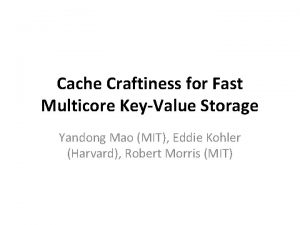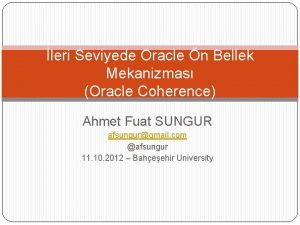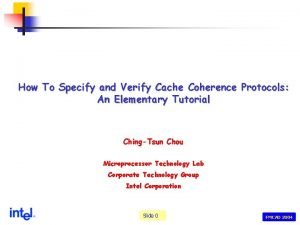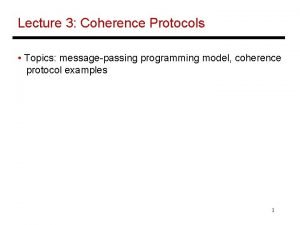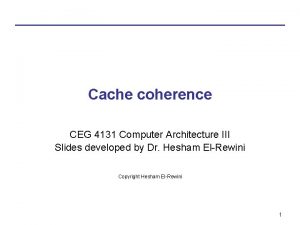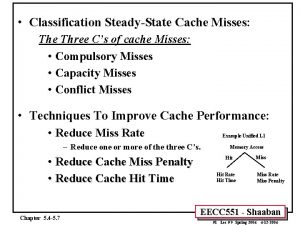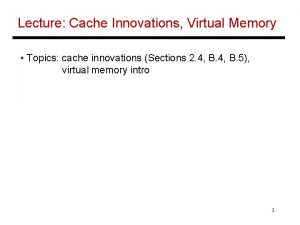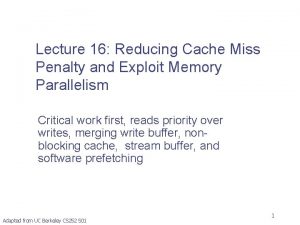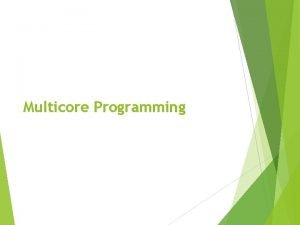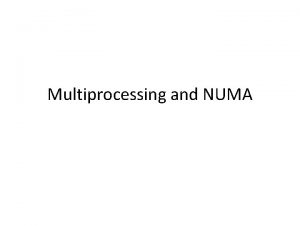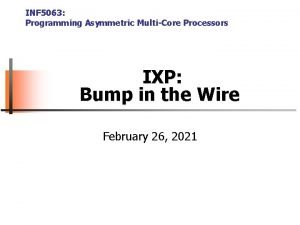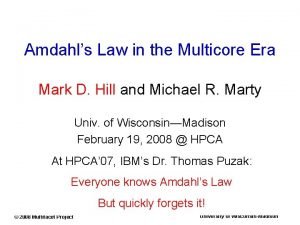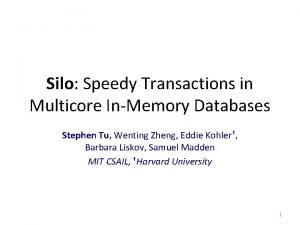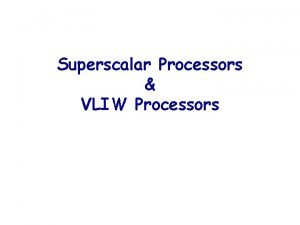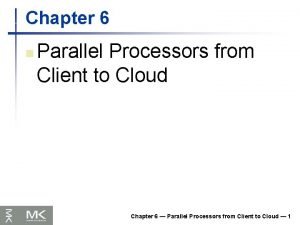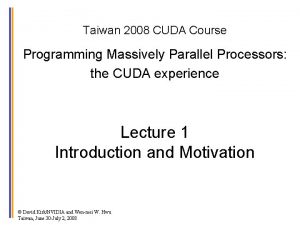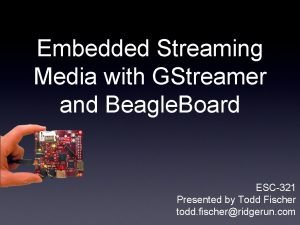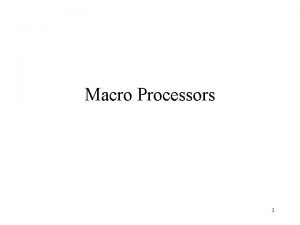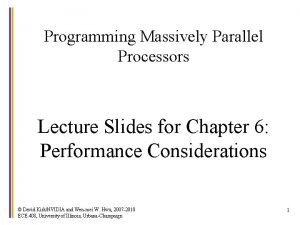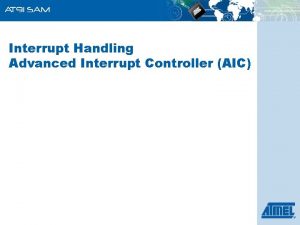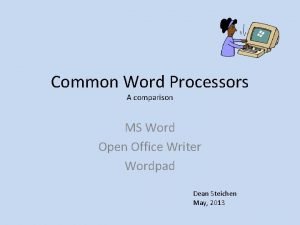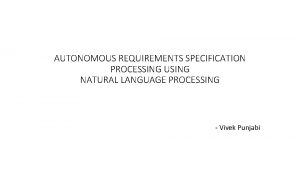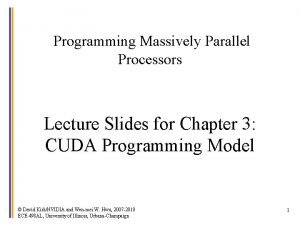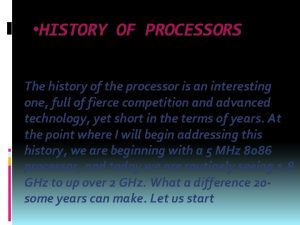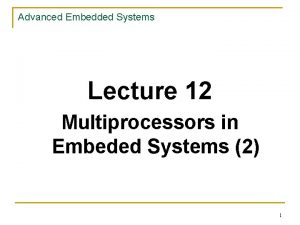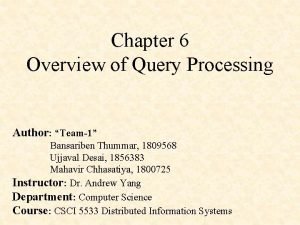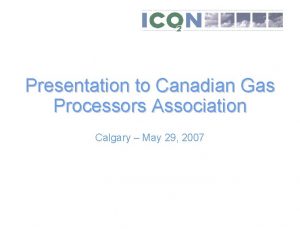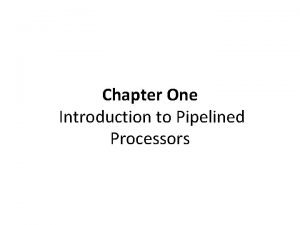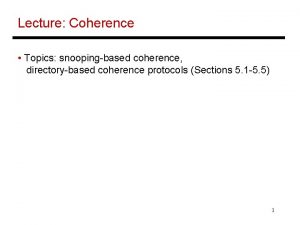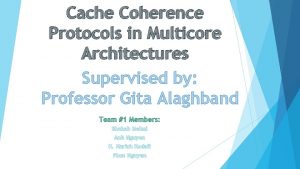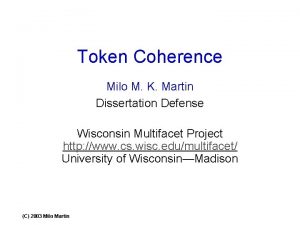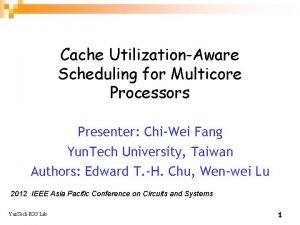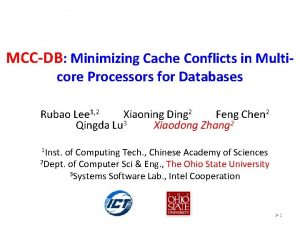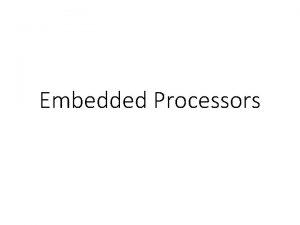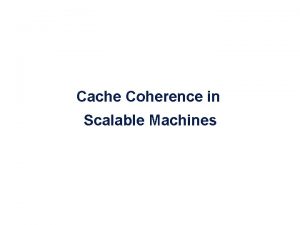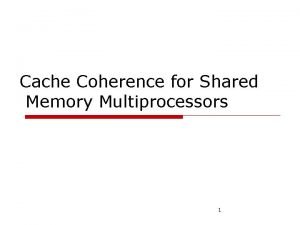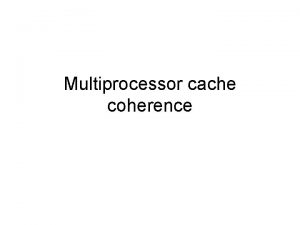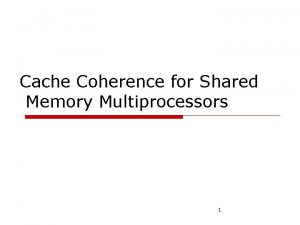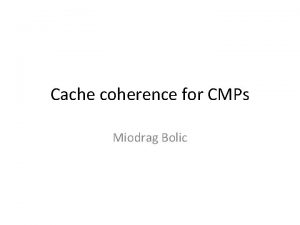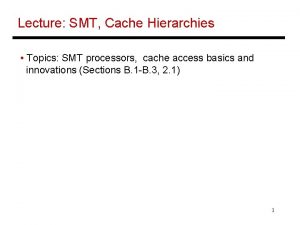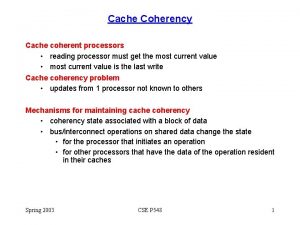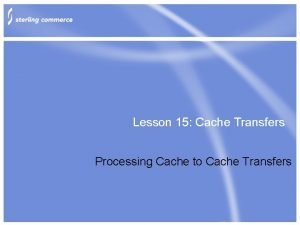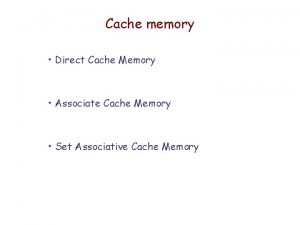Cache Coherence Techniques for Multicore Processors Dissertation Defense








![Outline Introduction and Motivation Virtual Hierarchies [ISCA 2007, IEEE Micro Top Pick 2008] • Outline Introduction and Motivation Virtual Hierarchies [ISCA 2007, IEEE Micro Top Pick 2008] •](https://slidetodoc.com/presentation_image/867574b9cdbfdfa1e8be497c46696867/image-9.jpg)





















































![Outline Introduction and Motivation Virtual Hierarchies Ring-based Coherence [MICRO 2006] • Skip, 5 -minute Outline Introduction and Motivation Virtual Hierarchies Ring-based Coherence [MICRO 2006] • Skip, 5 -minute](https://slidetodoc.com/presentation_image/867574b9cdbfdfa1e8be497c46696867/image-63.jpg)




























- Slides: 91

Cache Coherence Techniques for Multicore Processors Dissertation Defense Mike Marty 12/19/2007 1

Key Contributions Trend: Multicore ring interconnects emerging Challenge: Order of ring != order of bus Contribution: New protocol exploits ring order Trend: Multicore now the basic building block Challenge: Hierarchical coherence for Multiple-CMP is complex Contribution: Directory. CMP and Token. CMP Trend: Workload consolidation w/ space sharing Challenge: Physical hierarchies often do not match workloads Contribution: Virtual Hierarchies 2

Outline Introduction and Motivation • Multicore Trends Virtual Hierarchies • Focus of presentation Multiple-CMP Coherence Ring-based Coherence Conclusion 3

Is SMP + On-chip Integration == Multicore? Multicore P 0 $ P 1 $ bus $ P 2 $ P 3 memory controller 4

Multicore Trends Multicore P 0 $ P 1 $ bus $ P 2 $ P 3 memory controller Trend: On-chip Interconnect • Competes for same resources as cores, caches • Ring an emerging multicore interconnect 5

Multicore Trends Multicore P 1 P 0 $ Shared $$ bus Shared $$ $ P 2 P 3 memory controller Trend: latency/bandwidth tradeoffs • Increasing on-chip wire delay, memory latency • Coherence protocol interacts with shared-cache hierarchy 6

Multicore Trends Multicore P 0 $ Multicore P 1 $ P 0 $ bus $ P 2 $ P 3 bus memory controller Multicore P 0 $ $ P 2 $ P 3 memory controller Multicore P 1 $ P 0 $ bus $ P 2 P 1 $ $ P 3 P 1 $ bus memory controller $ P 2 $ P 3 memory controller Trend: Multicore is the basic building block • Multiple-CMP systems instead of SMPs • Hierarchical systems required 7

Multicore Trends Multicore VM 1 P 0 $ P 1 $ bus $ P 2 $ P 3 VM 2 VM 3 memory controller Trend: Workload Consolidation w/ Space Sharing • More cores, more workload consolidation • Space sharing instead of time sharing • Opportunities to optimize caching, coherence 8
![Outline Introduction and Motivation Virtual Hierarchies ISCA 2007 IEEE Micro Top Pick 2008 Outline Introduction and Motivation Virtual Hierarchies [ISCA 2007, IEEE Micro Top Pick 2008] •](https://slidetodoc.com/presentation_image/867574b9cdbfdfa1e8be497c46696867/image-9.jpg)
Outline Introduction and Motivation Virtual Hierarchies [ISCA 2007, IEEE Micro Top Pick 2008] • Focus of presentation Multiple-CMP Coherence Ring-based Coherence Conclusion 9

Space-sharing APP 1 APP 2 APP 3 APP 4 Virtual Hierarchy Motivations Server (workload) consolidation Tiled architectures 10

Motivation: Server Consolidation www server database server #2 64 -core CMP L 2 Cache Core L 1 database server #1 middleware server #1 11

Motivation: Server Consolidation www server database server #2 64 -core CMP database server #1 middleware server #1 12

Motivation: Server Consolidation www server database server #2 64 -core CMP database server #1 data middleware server #1 Optimize Performance 13

Motivation: Server Consolidation www server database server #2 64 -core CMP database server #1 middleware server #1 Isolate Performance 14

Motivation: Server Consolidation www server database server #2 64 -core CMP database server #1 middleware server #1 Dynamic Partitioning 15

Motivation: Server Consolidation www server database server #2 64 -core CMP database server #1 middleware server #1 VMWare’s Content-based Page Sharing Up to 60% reduced memory middleware server #1 Inter-VM Sharing 16

Outline Introduction and Motivation Virtual Hierarchies • • • Expanded Motivation Non-hierarchical approaches Proposed Virtual Hierarchies Evaluation Related Work Ring-based and Multiple-CMP Coherence Conclusion 17

Tiled Architecture Memory System L 2 Cache Memory Controller Core global broadcast too expensive 18 L 1

TAG-DIRECTORY A fwd 2 3 Read A data 1 get. M A duplicate tag directory 19

STATIC-BANK-DIRECTORY A 3 Read A data fwd 2 1 get. M A A 20

STATIC-BANK-DIRECTORY with hypervisor-managed cache 2 fwd A get. M A A 3 Read A data 1 21

Goals STATIC-BANK-DIRECTORY w/ hypervisor-managed cache {STATIC-BANK, TAG}-DIRECTORY Optimize Performance No Yes Isolate Performance No Yes Allow Dynamic Partitioning Yes ? Support Inter-VM Sharing Yes Hypervisor/OS Simplicity Yes No 22

Outline Introduction and Motivation Virtual Hierarchies • • • Expanded Motivation Non-hierarchical approaches Proposed Virtual Hierarchies Evaluation Related Work Ring-based and Multiple-CMP Coherence Conclusion 23

Virtual Hierarchies Key Idea: Overlay 2 -level Cache & Coherence Hierarchy - First level harmonizes with VM/Workload - Second level allows inter-VM sharing, migration, reconfig 24

VH: First-Level Protocol Goals: • Exploit locality from space affinity • Isolate resources Strategy: Directory protocol • Interleave directories across first-level tiles • Store L 2 block at first-level directory tile Questions: get. M • How to name directories? • How to name sharers? 25 INV

VH: Naming First-level Directory Select Dynamic Home Tile with VM Config Table • Hardware VM Config Table at each tile • Set by hypervisor during scheduling Example: p 12 p 13 p 14 per-Tile VM Config Table L 2 Cache Core Address …… 000101 offset 6 L 1 0 1 2 3 4 5 p 12 p 13 p 14 63 26 p 12 Dynamic Home Tile: p 14

VH: Dynamic Home Tile Actions Dynamic Home Tile either: • Returns data cached at L 2 bank • Generates forwards/invalidates • Issues second-level request get. M Stable First-level States (a subset): • Typical: M, E, S, I • Atypical: ILX: L 2 Invalid, points to exclusive tile SLS: L 2 Shared, other tiles share SLSX: L 2 Shared, other tiles share, exclusive to first level 27

VH: Naming First-level Sharers Any tile can share the block get. M INV Solution: full bit-vector • 64 -bits for 64 -tile system • Names multiple sharers or single exclusive Alternatives: • First-level broadcast • (Dynamic) coarse granularity 28

Virtual Hierarchies Two Solutions for Global Coherence: VHA and VHB memory controller(s) 29

Protocol VHA Directory as Second-level Protocol • Any tile can act as first-level directory • How to track and name first-level directories? Full bit-vector of sharers to name any tile • State stored in DRAM • Possibly cache on-chip + Maximum scalability, message efficiency - DRAM State ( ~ 12. 5% overhead ) 30

VHA Example 2 A 6 directory/memory controller get. M A data 1 data 3 5 Fwd A A 4 data 31

VHA: Handling Races Blocking Directories • Handles races within same protocol • Requires blocking buffer + wakeup/replay logic blocked A get. M A Inter-Intra Races • Naïve blocking leads to deadlock! blocked get. M A FWD A get. M A blocked A A get. M A 32 get. M A

VHA: Handling Races(cont) blocked get. M A FWD A get. M A blocked A A get. M A Possible Solution: • Always handle second-level message at first-level • But this causes explosion of state space Second-level may interrupt first-level actions: • First-level indirections, invalidations, writebacks 33

VHA: Handling Races(cont) Reduce the state-space explosion w/ Safe States: • Subset of transient states • Immediately handle second-level message • Limit concurrency between protocols Algorithm: • Level-one requests either complete, or enter safe-state before issuing level-two request • Level-one directories handle level-two forwards when a safe state reached (they may stall) • Level-two requests eventually handled by Level-two directory • Completion messages unblock directories 34

Virtual Hierarchies Two Solutions for Global Coherence: VHA and VHB memory controller(s) 35

Protocol VHB Broadcast as Second-level Protocol • Locate first-level directory tiles • Memory controller tracks outstanding second-level requestor Attach token count for each block • T tokens for each block. One token to read, all to write • Allows 1 -bit at memory per block • Eliminates system-wide ACK responses 36

Protocol VHB: Token Coalescing Memory logically holds all or none tokens: • Enables 1 -bit token count Replacing tile sends tokens to memory controller: • Message usually contains all tokens Process: • Tokens held in Token Holding Buffer (THB) • FIND broadcast initiated to locate other first-level directory with tokens • First-level directories respond to THB, tokens sent • Repeat for race 37

VHB Example 2 A get. M A memory controller 1 global get. M A 3 Data+tokens Fwd A 4 5 A 38

Goals Virtual Hierarchies: VHA and VHB STATIC-BANK-DIRECTORY w/ hypervisor-managed cache {DRAM, STATIC-BANK, TAG}-DIRECTORY Optimize Performance No Yes Isolate Performance No Yes Allow Dynamic Partitioning Yes ? Yes Support Inter-VM Sharing Yes Yes Hypervisor/OS Simplicity Yes No Yes 39

VHNULL Are two levels really necessary? VHNULL: first level only Implications: • • • Many OS modifications for single-OS environment Dynamic Partitioning requires cache flushes Inter-VM Sharing difficult Hypervisor complexity increases Requires atomic updates of VM Config Tables Limits optimized placement policies 40

VH: Capacity/Latency Trade-off Maximize Capacity • Store only L 2 copy at dynamic home tile • But, L 2 access time penalized • Especially for large VMs Minimize L 2 access latency/bandwidth: • Replicate data in local L 2 slice • Selective/Adaptive Replication well-studied ASR [Beckmann et al. ], CC [Chang et al. ] • But, dynamic home tile still needed for first-level Can we exploit virtual hierarchy for placement? 41

VH: Data Placement Optimization Policy Data from memory placed in tile’s local L 2 bank • Tag not allocated at dynamic home tile Use second-level coherence on first sharing miss • Then allocate tag at dynamic home tile for future sharing misses Benefits: • Private data allocates in tile’s local L 2 bank • Overhead of replicating data reduced • Fast, first-level sharing for widely shared data 42

Outline Introduction and Motivation Virtual Hierarchies • • • Expanded Motivation Non-hierarchical approaches Proposed Virtual Hierarchies Evaluation Related Work Ring-based and Multiple-CMP Coherence Conclusion 43

VH Evaluation Methods Wisconsin GEMS Target System: 64 -core tiled CMP • In-order SPARC cores • 1 MB, 16 -way L 2 cache per tile, 10 -cycle access • 2 D mesh interconnect, 16 -byte links, 5 -cycle link latency • Eight on-chip memory controllers, 275 -cycle DRAM latency 44

VH Evaluation: Simulating Consolidation Challenge: bring-up of consolidated workloads Solution: approximate virtualization • Combine existing Simics checkpoints 8 p checkpoint Memory 0 P 0 -P 7 PCI 0, DISK 0 64 p checkpoint P 0 -P 63 VM 0_Memory 0 VM 0_PCI 0, VM 0_DISK 0 script VM 1_Memory 0 VM 1_PCI 0, VM 1_DISK 0 45

VH Evaluation: Simulating Consolidation At simulation-time, Ruby handles mapping: • Converts <Processor ID, 32 -bit Address> to <36 -bit address> • Schedules VMs to adjacent cores by sending Simics requests to appropriate L 1 controllers • Memory controllers evenly interleaved Bottom-line: • Static scheduling • No hypervisor execution simulated • No content-based page sharing 46

VH Evaluation: Workloads OLTP, Spec. JBB, Apache, Zeus • Separate instance of Solaris for each VM Homogenous Consolidation • Simulate same-size workload N times • Unit of work identical across all workloads • (each workload staggered by 1, 000+ ins) Heterogeneous Consolidation • Simulate different-size, different workloads • Cycles-per-Transaction for each workload 47

VH Evaluation: Baseline Protocols DRAM-DIRECTORY: • 1 MB directory cache per controller • Each tile nominally private, but replication limited TAG-DIRECTORY: • 3 -cycle central tag directory (1024 ways). Nonpipelined • Replication limited STATIC-BANK-DIRECTORY • Home tiles interleave by frame address • Home tile stores only L 2 copy 48

VH Evaluation: VHA and VHB Protocols VHA • Based on Directory. CMP implementation • Dynamic Home Tile stores only L 2 copy VHB with optimizations • Private data placement optimization policy (shared data stored at home tile, private data is not) • Can violate inclusiveness (evict L 2 tag w/ sharers) • Memory data returned directly to requestor 49

Micro-benchmark: Sharing Latency 50

OLTP Apache Zeus A R K A N A IR B A 51 IR Spec. JBB B VH A TA -DIR G -D IR VH K A N M -B -D R VH A TA -DIR G -D IR VH D C TI A ST IR VH M -B -D D C TI A ST K A N TA -DIR G -D IR VH D C TI A ST A R M -B -D D C TI A ST Result: Runtime for 8 x 8 p Homogenous Consolidation

OLTP Apache C TI A ST -D IR B Zeus -D IR B 52 Spec. JBB B VH A TA DIR G -D IR VH K A N M A R -B D Result: Memory Stall Cycles for 8 x 8 p Homogenous Consolidation

OLTP Apache Zeus A R K A N A IR B A IR A 53 IR Spec. JBB B VH A TA -DIR G -D IR VH K A N M -B -D R B VH A TA -DIR G -D IR VH D C TI A ST IR VH M -B -D D C TI A ST K A N TA -DIR G -D IR VH D C TI A ST A R M -B -D D C TI A ST Result: Runtime for 16 x 4 p Homogenous Consolidation

OLTP Apache Zeus A R K A N A IR B A IR A 54 IR Spec. JBB B VH A TA -DIR G -D IR VH K A N M -B -D R B VH A TA -DIR G -D IR VH D C TI A ST IR VH M -B -D D C TI A ST K A N TA -DIR G -D IR VH D C TI A ST A R M -B -D D C TI A ST Result: Runtime for 4 x 16 p Homogenous Consolidation

Result: Heterogeneous Consolidation mixed 1 configuration 55

Result: Heterogeneous Consolidation mixed 2 configuration 56

Effect of Replication Treat tile’s L 2 bank as private Apache 8 x 8 p OLTP 8 x 8 p Zeus 8 x 8 p JBB 8 x 8 p 19. 7% 14. 4% 9. 29% 0. 06% STATIC-BANK-DIR -33. 0% 3. 31% -7. 02% -11. 2% TAG-DIR 1. 27% 3. 91% 1. 63% -0. 22% VHA n/a n/a VHB -11. 0% -5. 22% -0. 98% -0. 12% DRAM-DIR 57

Outline Introduction and Motivation Virtual Hierarchies • • • Expanded Motivation Non-hierarchical approaches Proposed Virtual Hierarchies Evaluation Related Work Ring-based and Multiple-CMP Coherence Conclusion 58

Virtual Hierarchies: Related Work Commercial systems usually support partitioning Sun (Starfire and others) • Physical partitioning • No coherence between partitions IBM’s LPAR • Logical partitions, time-slicing of processors • Global coherence, but doesn’t optimize space-sharing 59

Virtual Hierarchies: Related Work Systems Approaches to Space Affinity: • Cellular Disco, Managing L 2 via OS [Cho et al. ] Shared L 2 Cache Partitioning • Way-based, replacement-based • Molecular Caches ( ~ VHnull ) Cache Organization and Replication • D-NUCA, Nu. Rapid, Cooperative Caching, ASR Quality-of-Service • Virtual Private Caches [Nesbit et al. ] • More 60

Virtual Hierarchies: Related Work Coherence protocol implementations • Token coherence w/ multicast • Multicast snooping Two-level directory • Compaq Piranha • Pruning caches [Scott et al. ] 61

Summary: Virtual Hierarchies Contribution: Virtual Hierarchy Idea • Alternative to physical hard-wired hierarchies • Optimize for space sharing and workload consolidation Contribution: VHA and VHB implementations • Two-level virtual hierarchy implementations Published in ISCA 2007 and 2008 Top Picks 62
![Outline Introduction and Motivation Virtual Hierarchies Ringbased Coherence MICRO 2006 Skip 5 minute Outline Introduction and Motivation Virtual Hierarchies Ring-based Coherence [MICRO 2006] • Skip, 5 -minute](https://slidetodoc.com/presentation_image/867574b9cdbfdfa1e8be497c46696867/image-63.jpg)
Outline Introduction and Motivation Virtual Hierarchies Ring-based Coherence [MICRO 2006] • Skip, 5 -minute versions, or 15 -minute versions? Multiple-CMP Coherence [HPCA 2005] • Skip, 5 -minute versions, or 15 -minute versions? Conclusion 63

Contribution: Ring-based Coherence Problem: Order of Bus != Order of Ring • Cannot apply bus-based snooping protocols Existing Solutions • Use unbounded retries to handle contention • Use a performance-costly ordering point Contribution: RING-ORDER • Exploits round-robin order of ring • Fast and stable performance Appears in MICRO 2006 64

Contribution: Multiple-CMP Coherence Hierarchy now the default, increases complexity • Most prior hierarchical protocols use bus-based nodes Contribution: Directory. CMP • Two-level directory protocol Contribution: Token. CMP • Extend token coherence to Multiple-CMPs • Flat for correctness, hierarchical for performance Appears in HPCA 2005 65

Other Research and Contributions Wisconsin GEMS • ISCA ’ 05 tutorial, CMP development, release, support Amdahl’s Law in the Multicore Era • Mark D. Hill and Michael R. Marty, to appear IEEE Computer ASR: Adaptive Selective Replication for CMP Caches • Beckmann et al. , MICRO 2006 Log. TM-SE: Decoupling Hardware Transactional Memory from Caches, • Yen et al. , HPCA 2007 66

Key Contributions Trend: Multicore ring interconnects emerging Challenge: Order of ring != order of bus Contribution: New protocol exploits ring order Trend: Multicore now the basic building block Challenge: Hierarchical coherence for Multiple-CMP is complex Contribution: Directory. CMP and Token. CMP Trend: Workload consolidation w/ space sharing Challenge: Physical hierarchies often do not match workloads Contribution: Virtual Hierarchies 67

Backup Slides 68

What about Physical Hierarchy / Clusters? P P P P L 1 $ L 1 $ Shared L 2 L 1 $ L 1 $ P P P P 69

Physical Hierarchy / Clusters middleware server #1 www server database server #1 P P P P L 1 $ L 1 $ Shared L 2 L 1 $ L 1 $ P P P P Interference between workloads in shared caches Lots of prior work on partitioning single Shared L 2 Cache 70

Protocol VHNULL Example: Steps for VM Migration • from Tiles {M} to {N} 1. 2. 3. 4. Stop all threads on {M} Flush {M} caches Update {N} VM Config Tables Start threads on {N} 71

Protocol VHNULL Example: Inter-VM Content-based Page Sharing • Is read-only sharing possible with VHNULL? VMWare’s Implementation: • Global hash table to store hashes of pages • Guest pages scanned by VMM, hashes computed • Full comparison of pages on hash match Potential VHNULL Implementation: • How does hypervisor scan guest pages? Are they modified in cache? • Even read-only pages must initially be written at some point 72

5 -minute Ring Coherence 73

Ring Interconnect • Why? àShort, fast point-to-point links àFewer (data) ports àLess complex than packet-switched àSimple, distributed arbitration àExploitable ordering for coherence 74

Cache Coherence for a Ring • Ring is broadcast and offers ordering • Apply existing bus-based snooping protocols? • NO! • Order properties of ring are different 75

Ring Order != Bus Order {A, B} P 12 A P 9 P 3 B P 6 {B, A} 76

Ring-based Coherence Existing Solutions: 1. ORDERING-POINT • • Establishes total order Extra latency and control message overhead 2. GREEDY-ORDER • • Fast in common case Unbounded retries Ideal Solution • • Fast for average case Stable for worse-case (no retries) 77

New Approach: RING-ORDER + Requests complete in order of ring position • Fully exploits ring ordering + Initial requests always succeeds • No retries, No ordering point • Fast, stable, predictable performance Key: Use token counting • All tokens to write, one token to read 78

RING-ORDER Example = token P 12 P 11 = priority token P 1 P 9 get. M P 10 P 2 P 9 P 3 Store P 8 P 4 P 7 P 5 P 6 79

RING-ORDER Example = token P 12 P 11 = priority token P 1 P 9 get. M P 10 P 2 Furthest. Dest = P 9 P 3 Store P 8 P 4 P 7 P 5 P 6 80

RING-ORDER Example P 12 P 11 P 10 P 2 P 6 get. M P 9 Store P 3 Furthest. Dest = P 9 P 8 P 4 P 7 P 5 P 6 Store 81

RING-ORDER Example P 12 P 11 P 10 P 2 P 9 P 3 Store Complete P 8 P 4 P 7 P 5 P 6 Furthest. Dest = P 9 Store Complete 82

Ring-based Coherence: Results Summary System: 8 -core with private L 2 s and shared L 3 Key Results: • RING-ORDER outperforms ORDERING-POINT by 7 -86% with in-order cores • RING-ORDER offers similar, or slightly better, performance than GREEDY-ORDER • Pathological starvation did occur with GREEDY-ORDER 83

5 -minute Multiple-CMP Coherence 84

Problem: Hierarchical Coherence Intra-CMP protocol for coherence within CMP Inter-CMP protocol for coherence between CMPs Interactions between protocols increase complexity • explodes state space, especially without bus CMP 2 CMP 1 Inter-CMP Coherence interconnect CMP 3 Intra-CMP Coherence CMP 4 85

Hierarchical Coherence Example: Sun Wildfire Memory interface bus $ CPU • First-level bus-based snooping protocol • Second-level directory protocol • Interface is key: • Accesses directory state • Asserts “bus ignore” signal if necessary • Replays bus request when second-level completes 86

Solution #1: Directory. CMP Two-level directory protocol for Multiple-CMPs • Arbitrary interconnect ordering for on- and off-chip • Non-nacking. Safe States to help resolve races • Design of Directory. CMP led to VHA Advantages: • Powerful, scalable, solid baseline Disadvantages: • Complex (~63 states at interface), not model-checked? • Second-level indirections slow without directory cache 87

Improving Multiple CMP Systems with Token Coherence • Token Coherence allows Multiple-CMP systems to be. . . • Flat for correctness, but Low Complexity Fast • Hierarchical for performance Correctness Substrate CMP 2 CMP 1 Performance Protocol interconnect CMP 3 CMP 4 88

Solution #2: Token. CMP Extend token coherence to Multiple-CMPs • Flat for correctness, hierarchical for performance • Enables model-checkable solution Flat Correctness: • Global set of T tokens, pass to individual caches • End-to-end token counting • Keep flat persistent request scheme 89

Token. CMP Performance Policies Token. CMPA: • • Two-level broadcast L 2 broadcasts off-chip on miss Local cache responds if it has extra tokens Responses from off-chip carry extra tokens Token. CMPB: • On-chip broadcast on L 2 miss only (local indirection) Token. CMPC: Extra states for further filtering Token. CMPA-PRED: persistent request prediction 90

M-CMP Coherence: Summary of Results System: Four, 4 -core CMP Notable Results: • Token. CMP 2 -32% faster than Directory. CMP w/ inorder cores • Token. CMPA, Token. CMPB, Token. CMPC all perform similarly • Persistent request prediction greatly helps Zeus • Token. CMP gains diminished with out-of-order cores 91
 Cache craftiness for fast multicore key-value storage
Cache craftiness for fast multicore key-value storage Unity and coherence
Unity and coherence Cache coherence tutorial
Cache coherence tutorial Cache coherence protocols
Cache coherence protocols Chained cache coherence protocol
Chained cache coherence protocol Cache coherence for gpu architectures
Cache coherence for gpu architectures Cache coherence example
Cache coherence example What are the first line of defense
What are the first line of defense Techniques for reducing cache misses
Techniques for reducing cache misses Disadvantages of direct mapped cache
Disadvantages of direct mapped cache Techniques for reducing cache misses
Techniques for reducing cache misses Techniques for reducing cache misses
Techniques for reducing cache misses Multicore programming
Multicore programming Multiprocessor and multicore
Multiprocessor and multicore Asymmetric multicore processing
Asymmetric multicore processing And eat
And eat Autosar multicore
Autosar multicore Speedy transactions in multicore in-memory databases
Speedy transactions in multicore in-memory databases Pcie-1429
Pcie-1429 Multicore packet scheduler
Multicore packet scheduler Obs multicore
Obs multicore Vliw vs superscalar
Vliw vs superscalar Microcontrollers and embedded processors
Microcontrollers and embedded processors Parallel processors from client to cloud
Parallel processors from client to cloud Which pipeline is linear
Which pipeline is linear Programming massively parallel processors, kirk et al.
Programming massively parallel processors, kirk et al. Gstreamer architecture
Gstreamer architecture Digital camera processors
Digital camera processors Macro processor design options
Macro processor design options Programming massively parallel processors
Programming massively parallel processors Interrupt handling in arm processors
Interrupt handling in arm processors Network systems design using network processors
Network systems design using network processors Comparison of word processors
Comparison of word processors Advantages and disadvantages of intel processors
Advantages and disadvantages of intel processors Language and processors for requirement
Language and processors for requirement Programming massively parallel processors
Programming massively parallel processors The history of cpu
The history of cpu Conditional macro expansion
Conditional macro expansion Embeded processors
Embeded processors Characterization of query processors
Characterization of query processors Programming massively parallel processors
Programming massively parallel processors What is telecommunication network
What is telecommunication network Gas processors association
Gas processors association Handlers classification of parallel computing structure
Handlers classification of parallel computing structure Fonction technique scooter
Fonction technique scooter Ledningssystem för verksamhetsinformation
Ledningssystem för verksamhetsinformation Modell för handledningsprocess
Modell för handledningsprocess Varför kallas perioden 1918-1939 för mellankrigstiden
Varför kallas perioden 1918-1939 för mellankrigstiden Matematisk modellering eksempel
Matematisk modellering eksempel Shivaismen
Shivaismen Cks
Cks Inköpsprocessen steg för steg
Inköpsprocessen steg för steg Bo bergman jag fryser om dina händer
Bo bergman jag fryser om dina händer Strategi för svensk viltförvaltning
Strategi för svensk viltförvaltning Anatomi organ reproduksi
Anatomi organ reproduksi Typiska novell drag
Typiska novell drag Stickprovsvarians
Stickprovsvarians Rutin för avvikelsehantering
Rutin för avvikelsehantering Tack för att ni har lyssnat
Tack för att ni har lyssnat Läkarutlåtande för livränta
Läkarutlåtande för livränta Treserva lathund
Treserva lathund Hur skriver man en tes
Hur skriver man en tes Påbyggnader för flakfordon
Påbyggnader för flakfordon Tack för att ni lyssnade
Tack för att ni lyssnade En lathund för arbete med kontinuitetshantering
En lathund för arbete med kontinuitetshantering Tobinskatten för och nackdelar
Tobinskatten för och nackdelar Egg för emanuel
Egg för emanuel Atmosfr
Atmosfr Var finns arvsanlagen
Var finns arvsanlagen Programskede byggprocessen
Programskede byggprocessen Presentera för publik crossboss
Presentera för publik crossboss Rbk fuktmätning
Rbk fuktmätning Myndigheten för delaktighet
Myndigheten för delaktighet Kung som dog 1611
Kung som dog 1611 Vad är densitet
Vad är densitet Nationell inriktning för artificiell intelligens
Nationell inriktning för artificiell intelligens Tack för att ni har lyssnat
Tack för att ni har lyssnat Mall för referat
Mall för referat Start för skala
Start för skala Epiteltyper
Epiteltyper Magnetsjukhus
Magnetsjukhus Lufttryck formel
Lufttryck formel Vilket tal pekar pilen på
Vilket tal pekar pilen på Adressändring ideell förening
Adressändring ideell förening Toppslätskivling dos
Toppslätskivling dos Elektronik för barn
Elektronik för barn Borra hål för knoppar
Borra hål för knoppar Bra mat för unga idrottare
Bra mat för unga idrottare Smärtskolan kunskap för livet
Smärtskolan kunskap för livet Bris för vuxna
Bris för vuxna Vad är ett minoritetsspråk
Vad är ett minoritetsspråk Etik och ledarskap etisk kod för chefer
Etik och ledarskap etisk kod för chefer
